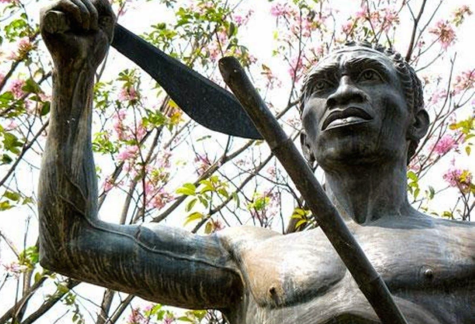

By Jacqueline Galindo Valadez
Overview
Exploring the enslavement of Africans and their historical experiences/contributions, as well as Afro-Mexican’s current lived experiences centered on identity. It is critical to explore Afro-Mexicans’ legacies (both in the past and present), where issues of Mexican blackness are continuously overlooked in popular discourse.
Slave Period
The black stars indicate the two main ports of slave arrivals in Veracruz and Campeche during the colonial period.
There are three main periods that describe the trajectory of African enslavement in New Spain (now considered Mexico): 1519 to 1580, 1580-1650, 1650-1827. During the first period, 1519 to 1580, African slaves accompanied Spanish invaders and conquistadors as companions and servants. On April 21, 1519, Hernan Cortés and his Spanish fleet arrived at the main port of entry in Veracruz. The first slaves to arrive in Veracruz believed to come from Angola and Congo, but over time, the majority of slaves were known as negros criollos because they were the first generation of slaves born in the Caribbean (Dixon, K. & Burdick, J., 2012).

The second period, 1580-1650, consisted of a rise in demand for African enslavement. Disease and rigors of the Spanish labor systems led to the rapid decline of indigenous populations, and the introduction and acceleration of African slavery. Bartolomé de Las Casas advocated for African enslavement as the way to replace dying and exploited indigenous populations. Racist rationalizations, such as Africans’ “superhumxn physical strength” (resistance to diseases and adaptation to climate change), compelled Spaniards to justify Black enslavement and believe one Black enslaved person was worth four indigenous persons (Simms, 2008).
The third period, 1650 to 1827, experienced a decline of the enslavement trade in African people and the enslaved Black population.
Gaspar Yang: Veracruz Slave Rebellion

In 1570, Gaspar Yanga led a slave revolt in a sugar plantation in Veracruz. Yanga led fellow slaves to nearby mountains where they spent time arming and supplying themselves in case of Spanish raids/attacks. It was not until 1609 that viceroy Luis de Velasco, along with other Spanish colonial powers, assembled troops to retake former slaves. The guerrilla warfare ended with several losses on both sides, where the former slaves and the Spanish eventually agreed to a treaty in 1618 that granted former slaves their freedom and right to establish an independent settlement.
The town of San Lorenzo de Los Negros (in Veracruz), now known as Yanga, was the first settlement of freed African slaves in the Americas (“Slave Rebellions,” 2017; “Gaspar Yanga,” 2015).
Resistance

In September of 1537, a group of African slaves in Mexico City organized a slave plot intended to dispossess all Spaniards. A slave reported the conspiracy, and Spanish authorities quickly intervened in the planned revolt. As a result, they banned the importation of African slaves for eight years because they feared Black and indigenous rebellions would undeniably threaten colonial rule. Over 100 rebellions, insurrections and conspiracies occurred between 1523 and 1823.
The outcome was a rebellion spirit among the oppressed and targeted classes, making New Spain one of the first places to resist slavery (Simms, 2008). The slave trade was abolished on December 19, 1817 and following Mexico’s independence, the Vicente Guerrero regime abolished slavery (on paper) in 1829 without much opposition from traditional pro-slavery forces, except for its territory of Texas.
Mestizaje

During colonial times, there was a clearly defined socio-racial structure composed of three distinct groups: a White Spanish elite minority exercising an immense of control in all realms, a large conquered and diminished indigenous population and a mass of enslaved Blacks that were ranked lowest in the social hierarchy. The Afro-Mexican population primarily declined because ofmiscegenation (racial mixture) and noxious racism.
- Miscegenation was a mechanism to fulfill the “ultimate goal of conquest: power and domination over others” by achieving blanqueamiento (“whitening”), and diluting Blackness (dissociation from Black roots). Miscegenation served as a tool of social and racial mobility, in which Afro-Mexicans were aware of white privilege in the context of improved socio-economic status. It is essential to consider the sexual objectification and exploitation of womxn of color, especially Black womxn, that led to the forced reproduction of a new nation (Simms, 2008).
- On September 27, 1822, the Mexican Congress enacted the Plan de Igualo, which barred the classification of persons by races in official government documents. This document served to justify the idea of a “racial democracy” which further encouraged the racialist ideology of “whitening”.
- Miscegenation of the Afro-Mexican population caused a decline in the Afro-Mexican population by the late 18th century. Descendants of Afro-Mexicans essentially lost their African heritage and became absorbed into larger caste groups, by which they are now incorrectly considered mestizos (racial mixture of indigenous and Spanish) (Simms, 2008).
- Anti-black racism also accounts for the decline of the Afro-Mexican population during colonial times (1521-1821), in which free peoples of African descent had to navigate through the hostile political, economic, and social discrimination imposed by the Spanish American caste system (Vaughn, Vinson, 2011). Afro-Mexicans, as well as Black slaves, were seen as inferior people of mala raza (bad race) and mala casta (bad caste), who were continuously exploited and abused. In La Raza cósmica, José Vasconcelos, depicted Blacks as a negative stain on racial progress.
- Inthe late 18th century, free Afro-Mexicans experienced restricted freedom economically with a decline in the slave based economy, and the initiation of a wage based society. It became more profitable and competitive to pay wages to Afro-Mexicans, rather than enslaved people. Therefore, Afro-Mexicans became a prominent group that fulfilled labor demands and sometimes endured harsher working conditions than Black slaves (Simms, 2008).
**As shown on the map, in 1800, the Black/Mulatto population was between 5-14%. In 1900, due to the Plan de Igualo, there was no available data for the percent of Black/Mulatto population. In 2000, the red shading demonstrates the 0-4% Black/Mulatto population. Evidently, miscegenation and racism were major contributors to the decline in Black/Mulatto population.**~
Afro-Mexican Identity

The concept of mestizaje has led to contradictions between the coexistence of Blackness and Mexican national identity. The preference of the term Afro-mestizo over Afro-Mexican demonstrates the overall preference of mestizaje over Blackness. But even the use of “afro” assumes a difference and further marginalizes this particular group, where Blackness is dissociated from a national identity. In 1989, the Third Root Program, meant to represent Afro-Latinx populations of la tercera raíz, had honest intentions of recognizing Afro-descendant communities but in the process became problematic because in a way created a division of Mexicans based on physical traits (Dixon, K. & Burdick, J., 2012).
A way Afro-Mexican communities are calling for recognition, in a country that continuously overlooks their lived experiences, is through grand exhibitions. Temporary exhibitions have begun to share the history of slavery and societal contributions of Afro-descendants. In 1995, the Museum of AfroMestizo Cultures opened in Cuajinicuilapa, Guerrero, in the Costa Chica region, with the support of the General Directorate of Popular Cultures of the National Council for Culture and the Arts, the municipal government and local communities. Photography exhibitions about Afro-descendant populations in Mexico have been organized in places such as Mexico City, Acapulco, Veracruz, Guanajuato. In August of 2011, the photography exhibition that had the greatest social impact was titled Abriendo los Ojos (Opening Our Eyes) and located on a main street in Mexico City. The exhibition included 30 large-format photographs of Afro-descendant communities in Oaxaca, Guerrero and Veracruz (Velázquez, M.).
Current Racial Demographics

Mexico’s historically Black populations did not migrate in large numbers to big cities and rather remained in concentrated communities in Oaxaca, Guerrero, and Veracruz. When Afro-Mexicans travel outside of their communities, they are targets of discrimination based on phenotype (Archibold, 2014). In 2015, the Mexican government finally recognized its 1.38 million citizens of African descent in a national survey. People claim the 2020 national census will include “Black” as an official category, which will provide Afro-Mexicans an opportunity to self-identify and become nationally recognized. An activist group, México Negro, founded by Sergio Peñaloza Pérez in 1997, fought for the constitutional and overall recognition of Afro-Mexicans (Varagur, 2016).
The 2015 Mexican Census indicates that the percent of Afro-descendant populations above 2.2% is primarily in the states of Guerrero, Oaxaca, and Veracruz. In Guerrero, 6.50% of the population consider themselves of Afro-descendant. In Oaxaca, 4.95% of the population claim they are of African descendant. Finally, 3.28% of Veracruz’s population consider themselves Afro-descendants.
Representation

In 2005, Mexican president Vicente Fox, spoke about the essentiality of Mexican immigrants to the U.S. economy, stating that they take the jobs “that not even Blacks want to do.” His statement underlined that Blackness served as a form of class marker. A few weeks after Fox’s commentary, in July 2005, the country released postage stamps “celebrating” Memín Penguín. Memín is a comic book character created in the 1940’s that resembles a “little black sambo”. Although there may have been alterations in the comic storyline throughout the years, the title character continues to feature characteristics drawings of Blacks from the era in which it was created– huge lips and an exaggeratedly broad flat nose (Tulloch, 2009).
The Memín/Fox episode had transnational effects, in which representatives from México Negro called for the withdrawal of the stamp and published an open letter to the president. Black leaders perceived the Memín controversy as a blind spot in Mexico, whereas others saw this character as a symbol of nationalist pride (Vaughn, Vinson, 2011). Many civil rights activists in the United States became angry and denounced the stamps as racist. Essentially, the Memín/Fox episode opened a discussion about Mexico’s blackness and anti-black racism in the context of a country who claims to be a “racial democracy”.
Migration to North Carolina

For at least 300 years, Mexico’s southern Costa Chica region has had one of the highest concentrations of Afro-Mexicans, who descended from African slaves transported by the Spanish from 1580s-1640s. Reasons such as family and friendship networks, as well as lucrative employment opportunities and an appealing climate, have led Afro-Mexicans to chose North Carolina (Winston-Salem and parts of Raleigh) as one of their major destinations. Afro-Mexicans from the Costa Chica (costeños) make up 80% of about 30,000 Latinx individuals in the Winston-Salem area.
Small businesses, such as the Costa Chica convenience store, serve as places to establish social relationships between people from the same region. Increased mestizaje in Mexico has led to a change in phenotype characteristics that have led to a lack of ethnic consciousness among migrant costeños. Moreover, cultivating ally and solidarity relationships becomes challenging between Afro-Mexicans and African Americans who struggle with recognizing Mexican blackness (Vaughn, Vinson, 2011).
References
- Archibold, R.C. (2014). Negro? Prieto? Moreno? A Question of Identity for Black Mexicans. The New York Times.
- Dixon, K. & Burdick, J. (2012). Performing the African Diaspora in Mexico in Comparative Perspectives on Afro-Latin America, pp. 93-113.
- Simms, E.Y. (2008). Miscegenation and Racism: Afro-Mexicans in Colonial New Spain. The Journal of Pan African Studies, Vol. 2:3.
- Vulloch, A. (2009). Afro-Mexicans: A Short Study on Identity. Graduate Degree Program in Anthropology and the Graduate Faculty of the University of Kansas.
- Varagur, K. (2016). Mexico Finally Recognized Its Black Citizens, But That’s Just The Beginning. Latino Voices, Huffington Post. Oath Inc.
- Vaughn, B. & Vinson. B. (2011). Unfinished Migrations: From the Mexican South to the American South — Impressions on Afro-Mexican Migration to North Carolina. In Beyond Slavery: The Multilayered Legacy of Africans in Latin American and the Caribbean, ed. Darién J. Davis, 223-245. Lanham, MD: Rowman and Littlefield.
- Velázquez, M.E. Africans and Afro-descendants in Mexico and Central America: overview and challenges of studies of their past and present. Collective Volume The Slave Route Project, UNESCO. Retrieved from: http://www.unesco.org/fileadmin/MULTIMEDIA/HQ/CLT/pdf/Maria_Elisa_Velazquez_Eng_01.pdf
- (2015). Gaspar Yanga: The First Liberator of the Americas. Latino Rebels. Retrieved from: http://www.latinorebels.com/2015/09/23/gaspar-yanga-the-first-liberator-of-the-americas/
- (2017). Slave Rebellions. Encyclopedia Britannica. Encyclopedia Britannica, Inc. Retrieved from: https://www.britannica.com/topic/slave-rebellions#ref1218356
Originally published by ESRI, republished with embed permission for educational, non-commercial purposes.






